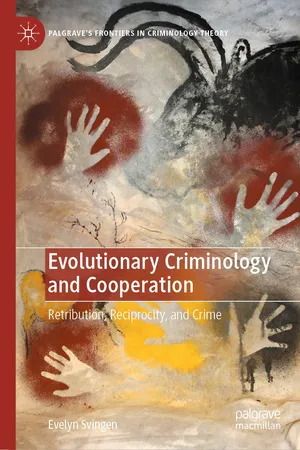
Evolutionary Criminology and Cooperation
Retribution, Reciprocity, and Crime
- English
- ePUB (mobile friendly)
- Available on iOS & Android
About this book
This book develops an evolutionary theory of crime. Both evolutionary theory and neurocriminology are growing fields that are attracting more and more interest for criminologists and wider fields alike. This book summarises important readings that relate to retribution and punishment and presents some neurocriminological findings. In addition, the book introduces a new methodology for the study of crime: a game theory experiment adapted from the field of behavioural economics. Overall, the book synthesises the key crime literature, presents a new theory of crime in a new field of evolutionary criminology and the methodology to study it, and provides empirical results in support of the theory. For any evolutionary and neuroscientist interested in deviance, this book offers a new model which is testable using more complex methods such as MRI scanners and survival simulations.
Frequently asked questions
- Essential is ideal for learners and professionals who enjoy exploring a wide range of subjects. Access the Essential Library with 800,000+ trusted titles and best-sellers across business, personal growth, and the humanities. Includes unlimited reading time and Standard Read Aloud voice.
- Complete: Perfect for advanced learners and researchers needing full, unrestricted access. Unlock 1.4M+ books across hundreds of subjects, including academic and specialized titles. The Complete Plan also includes advanced features like Premium Read Aloud and Research Assistant.
Please note we cannot support devices running on iOS 13 and Android 7 or earlier. Learn more about using the app.
Information
Table of contents
- Cover
- Front Matter
- 1. Evolutionary Theory and Crime: How Evolutionary Criminology Can Help Us Solve Criminology’s Theoretical Crisis
- 2. Introducing the Retribution and Reciprocity Model: An Evolutionary Theory of Crime
- 3. The Neurophysiology of the Retribution and Reciprocity Model: The Anatomy of Cooperation
- 4. Retribution, Reciprocity, and Vignettes: Testing the Retribution and Reciprocity Model through Hypothetical Scenarios
- 5. Retribution, Reciprocity, and Crime: Using a Public Goods Game to Measure People’s Prosociality and Criminality
- 6. Lessons Learned: What We Know About Retribution, Reciprocity, and Crime
- Back Matter